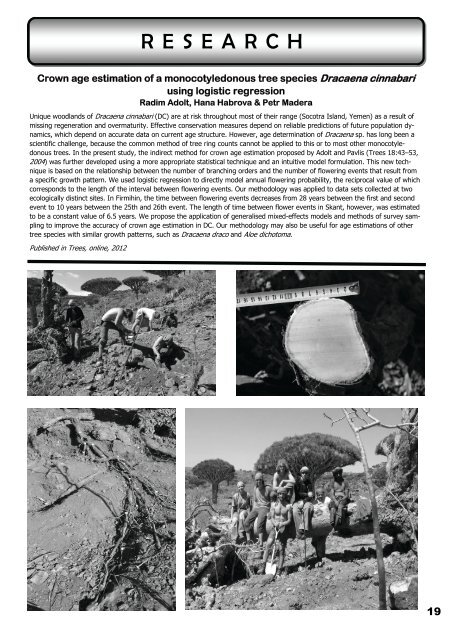TAYF the Soqotra Newsletter - Friends of Soqotra
TAYF the Soqotra Newsletter - Friends of Soqotra
TAYF the Soqotra Newsletter - Friends of Soqotra
Create successful ePaper yourself
Turn your PDF publications into a flip-book with our unique Google optimized e-Paper software.
Crown age estimation <strong>of</strong> a monocotyledonous tree species Dracaena cinnabari<br />
using logistic regression<br />
Radim Adolt, Hana Habrova & Petr Madera<br />
Unique woodlands <strong>of</strong> Dracaena cinnabari (DC) are at risk throughout most <strong>of</strong> <strong>the</strong>ir range (Socotra Island, Yemen) as a result <strong>of</strong><br />
missing regeneration and overmaturity. Effective conservation measures depend on reliable predictions <strong>of</strong> future population dynamics,<br />
which depend on accurate data on current age structure. However, age determination <strong>of</strong> Dracaena sp. has long been a<br />
scientific challenge, because <strong>the</strong> common method <strong>of</strong> tree ring counts cannot be applied to this or to most o<strong>the</strong>r monocotyledonous<br />
trees. In <strong>the</strong> present study, <strong>the</strong> indirect method for crown age estimation proposed by Adolt and Pavlis (Trees 18:43–53,<br />
2004) was fur<strong>the</strong>r developed using a more appropriate statistical technique and an intuitive model formulation. This new technique<br />
is based on <strong>the</strong> relationship between <strong>the</strong> number <strong>of</strong> branching orders and <strong>the</strong> number <strong>of</strong> flowering events that result from<br />
a specific growth pattern. We used logistic regression to directly model annual flowering probability, <strong>the</strong> reciprocal value <strong>of</strong> which<br />
corresponds to <strong>the</strong> length <strong>of</strong> <strong>the</strong> interval between flowering events. Our methodology was applied to data sets collected at two<br />
ecologically distinct sites. In Firmihin, <strong>the</strong> time between flowering events decreases from 28 years between <strong>the</strong> first and second<br />
event to 10 years between <strong>the</strong> 25th and 26th event. The length <strong>of</strong> time between flower events in Skant, however, was estimated<br />
to be a constant value <strong>of</strong> 6.5 years. We propose <strong>the</strong> application <strong>of</strong> generalised mixed-effects models and methods <strong>of</strong> survey sampling<br />
to improve <strong>the</strong> accuracy <strong>of</strong> crown age estimation in DC. Our methodology may also be useful for age estimations <strong>of</strong> o<strong>the</strong>r<br />
tree species with similar growth patterns, such as Dracaena draco and Aloe dichotoma.<br />
Published in Trees, online, 2012<br />
RESEARCH<br />
19


